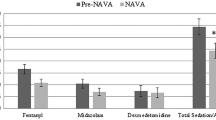Abstract
The hybrid pathway for the management of patients with hypoplastic left heart syndrome was pioneered at our institution and is the preferred approach compared with the traditional Norwood pathway. Patients undergoing this surgery are generally <6 months of age, and pain management in this age group after surgery for complex congenital heart disease (CHD) may be particularly challenging. We retrospectively reviewed our pain-management strategy after stage 1 hybrid procedure (HS1) and evaluated its efficacy, especially in the setting of early tracheal extubation. We retrospectively reviewed the records of patients receiving fentanyl analgesia after HS1 palliation for single-ventricle anatomy between June 2008 and August 2011. In addition to demographic data, we also recorded the mode of analgesia, total fentanyl administered during the first 48 postoperative hours, and total hours of fentanyl use. Other data collected included pain scores, adverse effects, time of tracheal extubation, and use of adjunctive medications, such as dexmedetomidine. Nurse-controlled analgesia (NCA) with fentanyl was used in 21 of the 33 patients in the study cohort, with the remainder receiving a continuous fentanyl infusion. NCA-fentanyl was the method of choice in 12 of the 13 patients whose tracheas were extubated in the operating room versus 9 of 20 patients who received postoperative mechanical ventilation and tracheal intubation (p = 0.0093). During the first and second 24 h after surgery, fentanyl requirements were lower in patients whose tracheas were extubated (11.8 ± 7.6 vs. 20.6 ± 18.1 and 6.6 ± 10.3 vs. 24.3 ± 20.4 μg/kg, respectively). Adverse effects were noted in 3 of the 33 patients (9%) and included one episode each of respiratory depression requiring reintubation of the trachea, pruritus, and excessive sedation. Dexmedetomidine was used as an adjunct medication in 5 patients and resulted in decreased fentanyl use (6.3 ± 1.3 vs. 19 ± 15.9 μg/kg in the first 24 postoperative hours and 7.9 ± 3.5 vs. 19 ± 20.3 μg/kg in the second 24 postoperative hours). Fentanyl administered by way of continuous infusion or NCA provided effective postoperative analgesia with a limited adverse effect profile after HS1 surgery in neonates with complex CHD. Fentanyl requirements were lower in patients who achieved early tracheal extubation as well as those who received dexmedetomidine.
Similar content being viewed by others
References
Winch PD, Nicholson L, Isaacs J, Spanos S, Olshove V, Naguib A (2009) Predictors of successful early extubation following congenital cardiac surgery in neonates and infants. Heart Lung Circ 18:271–276
Alghamdi AA, Singh SK, Hamilton BC et al (2010) Early extubation after pediatric cardiac surgery: Systematic review, meta-analysis, and evidence-based recommendations. J Card Surg 25:586–595
Naguib A, Winch P, Schwartz L et al (2010) Anesthetic management of the hybrid stage 1 procedure for hypoplastic left heart syndrome (HLHS). Pediatr Anesth 20:38–46
Galantowicz M, Cheatham JP (2005) Lessons learned from the development of a new hybrid strategy for the management of hypoplastic left heart syndrome. Pediatr Cardiol 26:190–199
Galantowicz M, Cheatham JP, Phillips A et al (2008) Hybrid approach for hypoplastic left heart syndrome: Intermediate results after the learning curve. Ann Thorac Surg 85:2063–2070
Iodice FG, Thomas M, Walker I et al (2011) Analgesia in fast-track paediatric cardiac patients. Eur J Cardiothorac Surg 40:610–613
Howard RF, Lloyd-Thomas A, Thomas M et al (2010) Nurse-controlled analgesia (NCA) following major surgery in 10,000 patients in a children’s hospital. Pediatr Anesth 20:126–134
Morton NS, Errera A (2010) APA national audit of pediatric opioid infusions. Pediatr Anesth 20:119–125
Tobias JD (2007) Dexmedetomidine: applications in pediatric critical care and pediatric anesthesiology. Pediatr Crit Care Med 8:115–131
Author information
Authors and Affiliations
Corresponding author
Rights and permissions
About this article
Cite this article
Naguib, A.N., Dewhirst, E., Winch, P.D. et al. Pain Management After Surgery for Single-Ventricle Palliation Using the Hybrid Approach. Pediatr Cardiol 33, 1104–1108 (2012). https://doi.org/10.1007/s00246-012-0233-8
Received:
Accepted:
Published:
Issue Date:
DOI: https://doi.org/10.1007/s00246-012-0233-8




